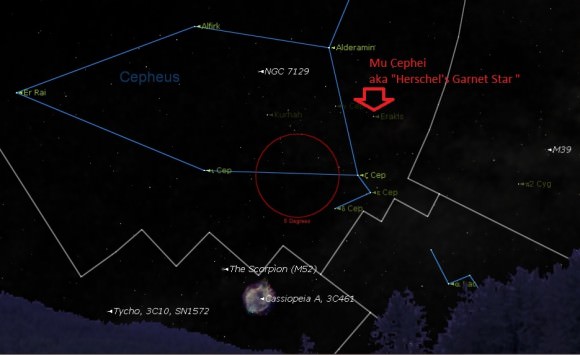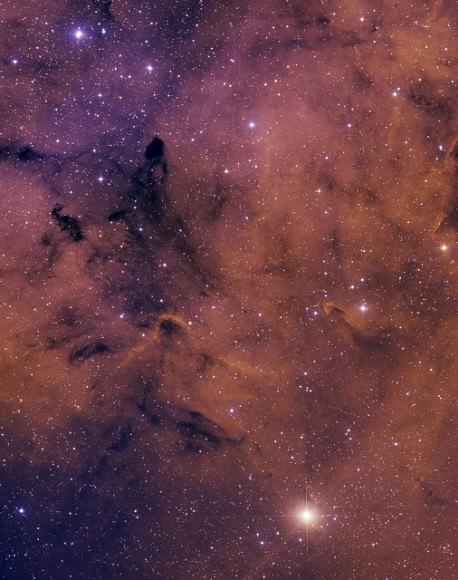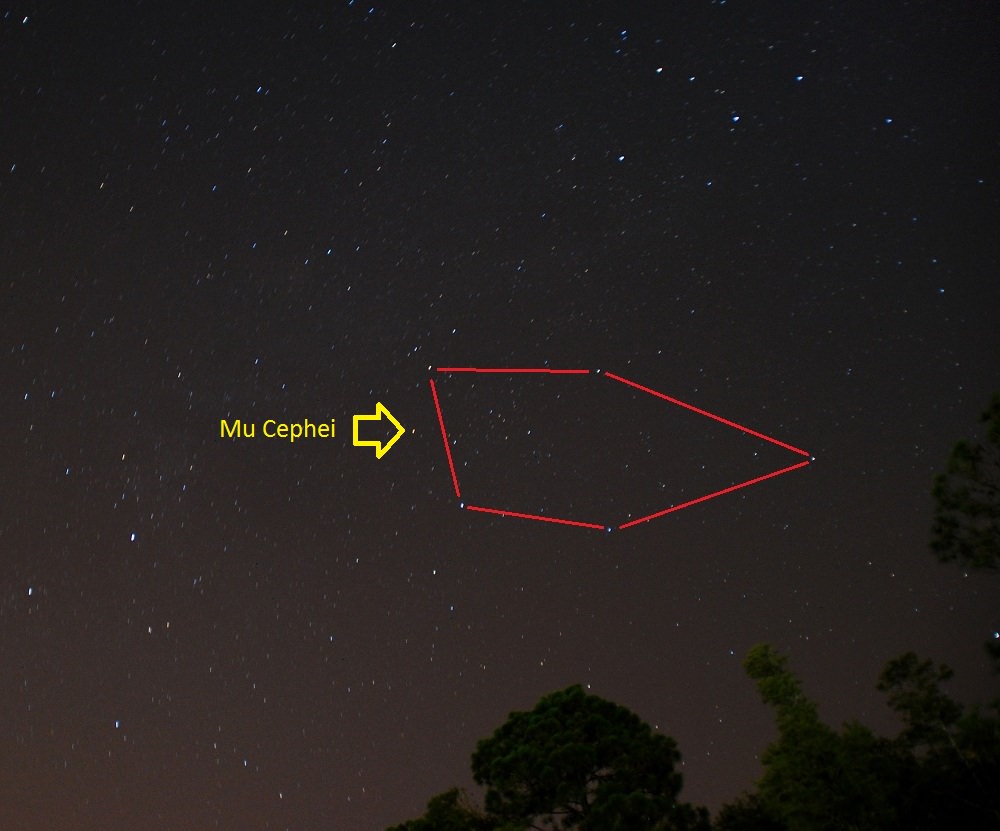Quick, what’s the reddest star visible to the naked eye?
Depending on your sky conditions, your answer may well be this week’s astronomical highlight.
Mu Cephei, also known as Herschel’s Garnet Star, is a ruddy gem in the constellation Cepheus near the Cygnus/Lacerta border. A variable star ranging in brightness by a factor of about three-fold from magnitudes 5.0 to 3.7, Mu Cephei is low to the northeast for mid-northern latitude observers in July at dusk, and will be progressively higher as summer wears on.
William Herschel first came across this colorful star, and gave it its nickname while surveying the region in 1783. He noted “A very fine deep garnet color” for the star, and the name stuck. He also went on to describe Mu Cephei as “A most beautiful object, especially if we look for some time at a white star before we turn our telescope to it, such as (+2.5 magnitude) Alpha Cephei, which is near at hand.”
Herschel was referring to the color contrast that often occurs when suddenly being confronted with such a visually colorful object in what is often a grey-to-white universe. Curiously, Herschel also notes how earlier stellar cartographers missed this star, perhaps due to its variability. Mu Cephei varies on average over a span of 755 days, although periods as short as 100 days and as long as 12.8 years are also superimposed over the cycle.

Johann Bayer first noted this star with its Greek letter designation of Mu Cephei in the 1600’s, although its variable nature was not recorded until 1848 by John Russell Hind. Hind is also famous for the discovery of another ruddy jewel and star party secret weapon, Hind’s Crimson Star in the constellation Lepus.
Mu Cephei is also sometimes referred to by the Arabic name Erakis. The name brings to mind the desert world Arrakis of Dune fame, which in the fictional universe of Frank Herbert, orbits around the real world star Canopus. Where the name Erakis comes from isn’t immediately clear, although there’s conjecture that early star map compilers confused it with Mu Draconis.
According to Star Names, Their Lore & Meaning by Richard Hinckley Allen, Mu Cephei was entered by Giuseppe Piazzi as Herschel’s “Garnet Star” in his late 18th century Palermo catalog.
What color does Herschel’s Garnet Star appear to you? One thing I always like about observing colored stars is comparing and contrasting different observers’ opinions. Mu Cephei sits at the coordinates;
Right Ascension: 21 Hours 43’ 30”
Declination: +58° 46’ 48”
This can put it high overhead late on Summer evenings and progressively earlier as we head towards Fall.
Mu Cephei also sits embedded in the extensive nebulosity of IC 1396, a wonderfully rich region for astrophotographers.

The “redness” of a star is measured by the magnitude contrast that it shows when comparing its brightness when viewed with a blue,versus a green (visible light) filter. This is the B-V index of a star. In the case of Herschel’s Garnet Star, the B-V magnitude index is +2.35. This is only slightly less than La Superba at +2.5. Contrast that with the familiar orange-tinted stars of Antares (B-V +1.83) & Betelgeuse (+1.85).
Colored variable stars appear redder when near their minima. The good news is, we’re currently near a maximum in brightness for Mu Cephei. In the case of Herschel’s Garnet Star, it appears to fade from orange to red as it cycles. An optical illusion, known as the Purkinje effect, can often cause an observer to overestimate the brightness of a crimson-colored star. The longer you stare at it, the brighter it appears. Throwing the star out of focus slightly can cause this apparent change in brightness to vanish.
Burnham’s Celestial Handbook notes that Mu Cephei “Appears a deep orange-red, but on occasion takes on a peculiar purple tint.” Can you see this spurious effect? We think it’s interesting that Herschel chose the word “garnet” to describe this star, as the gemstone can vary from shades of red to orange to even green!
Stars like Mu Cephei are also great targets, as they hold up well under light-polluted suburban skies. Herschel’s Garnet Star is also the reddest of the non-carbon stars.
And that leads us to the “wow factor” of what you’re truly seeing. Mu Cephei is a class M2Ia Supergiant star, about 2,400 light years distant (estimates still vary widely). It shines with a luminosity of 600,000 times that of our own Sun, making it one of the brightest known stars in the Milky Way. Move Mu Cephei to the standard absolute magnitude distance of 32.6 light years, and it would shine at magnitude -7.6, 16x times brighter than Venus at its best.
Mu Cephei is also 19 times more massive than our Sun, and has a radius of 1,650 times larger than Sol. Place Mu Cephei in our solar system, and it would extend out to the orbit of the planet Saturn. This makes Mu Cephei one of the largest stars known in terms of volume, with only a handful of larger stars known. It also “stars” (bad pun intended) in this classic video on astronomical scale;
The surface temperature of Mu Cephei is also relatively cool among stars, if you consider 3,690 Kelvin to be cool. Astronomers also detected water vapor in the spectrum of the star as early as 1964, another rarity. Massive stars such as Mu Cephei are destined to “live fast, die young” with life spans measured in the millions of years instead of the sedate billions of year life span of stars like our own Sun. Mu Cephei will one day grace our skies with a fine supernova, an event that could be on its way tomorrow night or millions of years from now.
All food for thought as you track down this fine scarlet delight in Cepheus, just as Sir William Herschel did centuries ago.


There is a carbon star adjacent to one of the members of Crux. Looks good in an 8 inch and fantastic in a 16 inch. If you keep the Crux star out of the field of view it will make this dim but blood red object stand out. Even without go-to its not very hard to find.
Sounds like you’re describing 9th magnitude DY Crucis (aka Espin-Birmingham 365) near Mimosa (Beta Crucis): http://www.flickr.com/photos/sebastionphoto/5616273842/
It looks like a wonderful pair although a little too far south to be seen from my locale (Tampa). The extreme B-V mag of this star (5.8) is similar to Hind’s Crimson Star (aka R Leporis, B-V=5.7) which I have seen on several occasions. Hind’s description of R Leporis, “like a drop of blood on a black field”, seems appropriate.
Astronomer Brian Skiff has compiled a short list of “very red” stars visible in binoculars or small amateur scopes:ftp://ftp.lowell.edu/pub/bas/starcats/bsa.red
Thanks Jon! That’s the star. I’ll grab that list and see what else I can track down.
I saw something bright in Cepheus just like 10-15 min ago. Like REALLY bright. The brightness only lasted for a few seconds. I’d confuse it with a meteor if it was moving but it wasn’t. Maybe this was it?